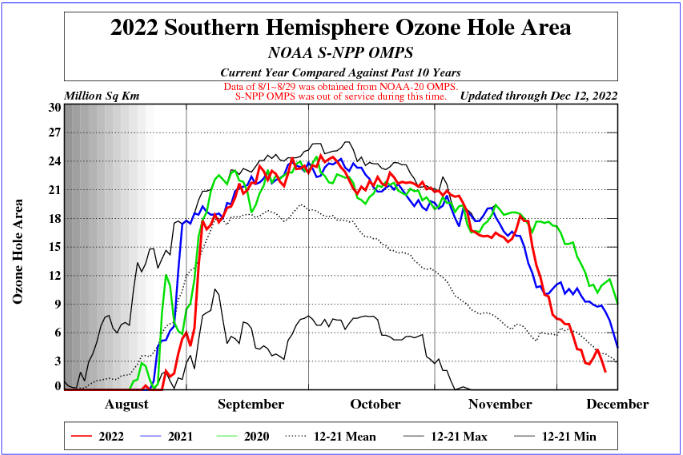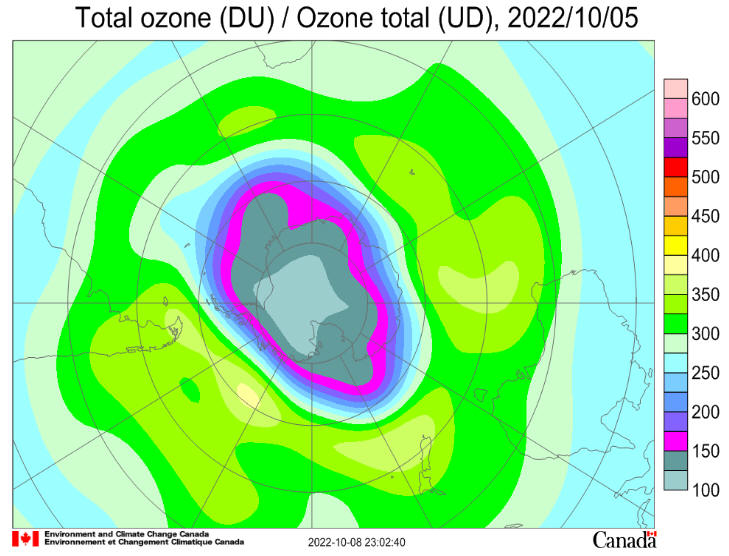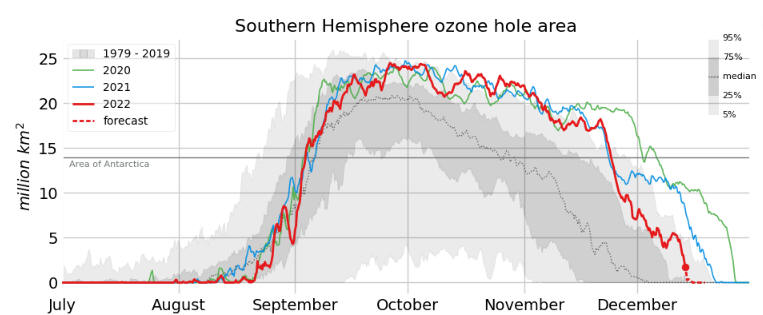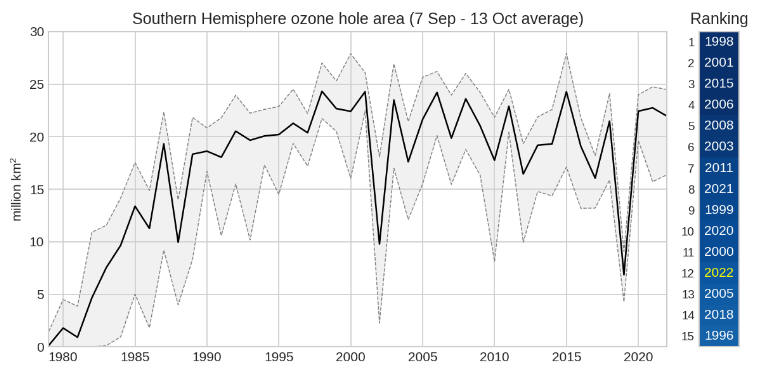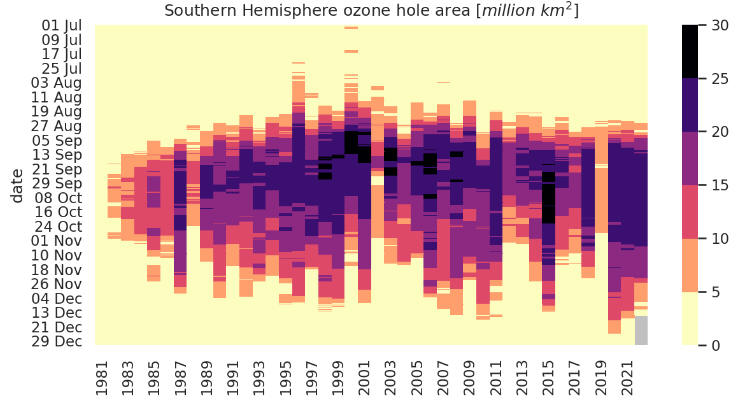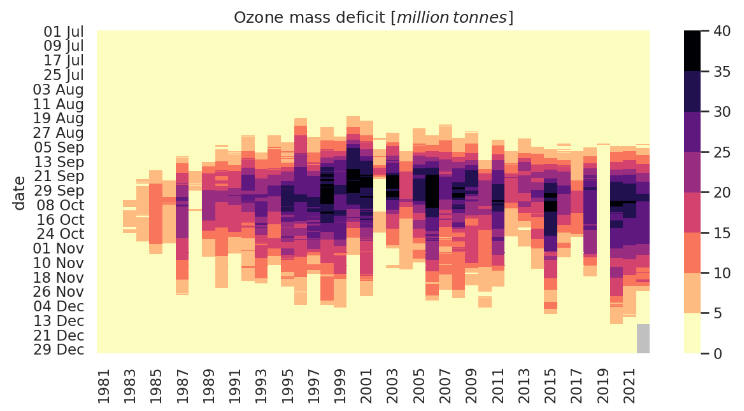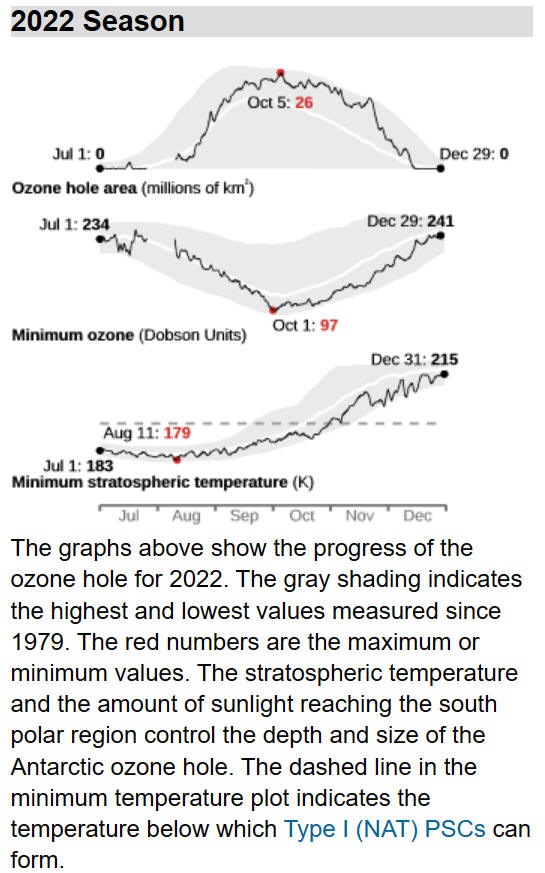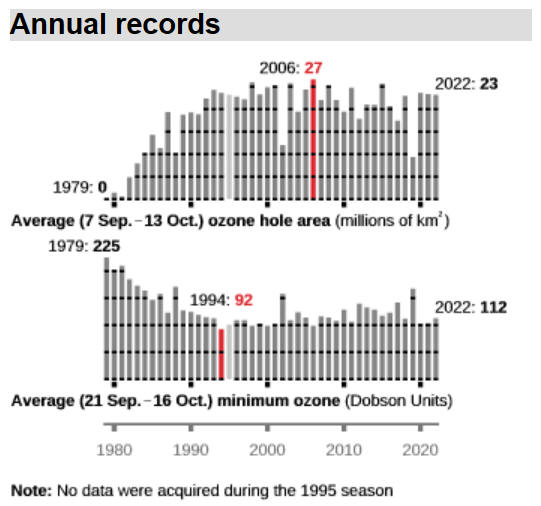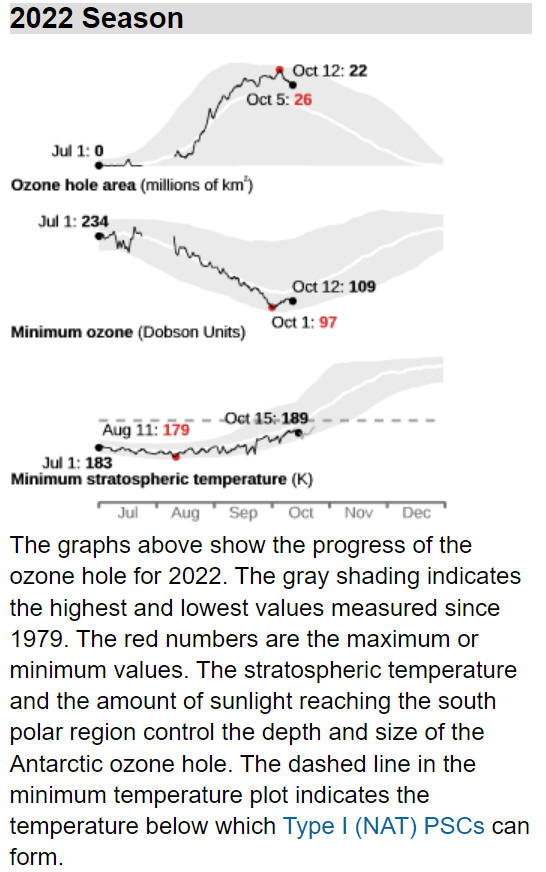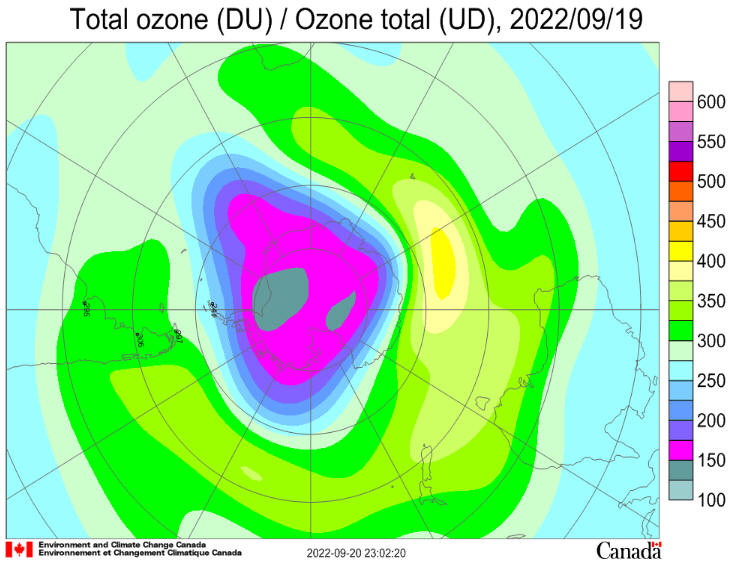|
The Ozone Hole 2022
Climate Prediction Center - Stratosphere: SBUV-2 Total Ozone - Ozone Hole (noaa.gov)
13th December 2022 The Copernicus Atmosphere Monitoring Service As the 2022 Antarctic ozone hole season comes to an end, the Copernicus Atmosphere Monitoring Service (CAMS) data shows this year’s ozone hole is closing later than most of the ones of the previous 40 years and, despite the signs of recovery of the ozone layer, it is still within the 15 largest in our record dating back to 1979. A similar pattern was observed in 2020 (the longest-lived on record, closing on 28 December) and 2021, the 8th largest ozone hole, that extended until 23 December. As the Antarctic ozone hole season comes to an end for another year, the CAMS analysis shows this 2022 ozone hole followed a peculiar pattern, similar to those of the two previous years but quite distinctly different from the previous 40 years. The beginning of the season was fairly average, with the ozone hole opening late September, at the start of Austral Spring. The maximum ozone hole area is reached at the end of September, slightly later than the average based on ozone data between 1979 and 2019. But while the average ozone hole area generally decreases quickly in October and even faster in November, in the last three years we have seen the ozone hole persisting into November and closing well into December, with the longest-lasting on record in 2020 closing on 28 December.
In order to put the size of the last three ozone holes into perspective, we have considered the average ozone hole area between 7 September and 13 October since 1979. The 2022 ozone hole ranks as the 12th largest. The year 2021 as the 8th largest and 2020 comes in 10th position. The “Top 15” shows even further how the last three years are a relatively rare pattern after a decreasing trend since the 2000s, subject to a high variability. Put differently, five of the top 15 larger area years happened in the 2010s, four during the 2000s but all three of the 2020s enter the list of the largest ozone hole area years.
In 2022, after a slow decrease of the extent of the ozone hole in October and most of November, we observed a fast decrease in late November, as a consequence of a rapid change in the conditions. Like every year, the arrival of the Austral summer relatively warmer stratospheric temperatures causes the polar vortex to break up, mixing higher ozone values from mid-latitudes to the south polar region, filling up the ozone-depleted area and closing the hole. The following heatmap illustrates how the Antarctic ozone hole season has evolved since 1979. In 2022, the maximum ozone hole area of nearly 25 million km2 is reached slightly later than the average and it persists consistently with a large area until December.
Heatmap showing the extent of each Antarctic ozone hole below the 60th parallel south since 1979 and the date. The last seasons have been unusually long. (Data for 2022 recorded until 13 December) Credit: CAMS The ozone mass deficit heatmap provides a different perspective of the same behavior. To obtain the ozone mass deficit we calculate the amount of ozone that would need to be added to the atmosphere to take the total ozone column, across the ozone hole area, to 220 Dobson units (the level required to “fill-up” the ozone hole).
Heatmap showing the ozone mass deficit below the 60th parallel south since 1979. The last three years show an ozone hole unusually deep later than average in the season. (Data for 2022 recorded until 13 December) Credit: CAMS It is worth noting that only one year before, 2019 marked the smallest ozone hole on record, due to an intense sudden stratospheric warming episode. The ozone mass deficit was consistently below 5 Megatons during the whole season, so it doesn’t show any signal in the chart above. This, along with other similar episodes in every decade shows the ozone hole is subject to the relatively high variability of the stratosphere thermal and dynamical conditions from year to year. Indeed, the concentrations of Ozone Depleting Substances (ODS) in the stratosphere vary slowly and are on a decreasing trend since the late 1990s thanks to the Montreal Protocol. Nevertheless, the fact that this extended “ozone hole season” is repeating for the third time in a row suggests that there could be changing factors in the South Pole stratosphere. Three peculiar Antarctic ozone hole seasons in a row: what we know | Copernicus In early October the 2022 Ozone Hole grew in size to become one of the largest ever.
National Oceanic and Atmospheric Administration October 26, 2022 NASA The hole in the ozone layer — the portion of the stratosphere that protects our planet from the sun’s ultraviolet rays — is continuing to decrease. The hole over Antarctica had an average area of 8.91 million square miles (23.2 million square kilometers). That measurement is slightly smaller than the extent of 8.99 million square miles (23.3 million square kilometers) reached last year, and well below the average seen in 2006 when the hole size peaked. “Over time, steady progress is being made and the hole is getting smaller,” said Paul Newman, chief scientist for Earth Sciences at NASA’s Goddard Space Flight Center. “We see some wavering as weather changes and other factors make the numbers wiggle slightly from day to day and week to week. But overall, we see it decreasing through the last two decades. Eliminating ozone-depleting substances through the Montreal Protocol is shrinking the hole.” The ozone hole happens when the protective ozone layer in the stratosphere above the South Pole begins to thin every September. Chlorine and bromine derived from human-produced compounds are released from reactions on high-altitude polar clouds. The chemical reactions then begin to deplete the ozone layer as the sun rises at the end of the winter in the Southern Hemisphere, with the strongest depletion occurring above Antarctica. Different methods of measurement NOAA and NASA researchers detect and measure the growth and breakup of the ozone hole with satellite instruments aboard Aura, Suomi-NPP and NOAA-20 satellites. This year, satellite observations determined the ozone hole area reached a single-day maximum of 10.2 million square miles (26.4 million square kilometers) on October 5, but is now shrinking. NOAA scientists at the South Pole Station also record the ozone layer's thickness by releasing weather balloons carrying ozone-measuring instruments called ozonesondes that measure the varying ozone concentrations, measured in Dobson Units, as the balloon rises into the stratosphere. The lowest column amount detected by ozonesondes at the South Pole this year was 101 Dobson Units on October 3, according to Bryan Johnson from NOAA’s Global Monitoring Laboratory. This is very similar to last year’s measurements. At altitudes between 8 and 13 miles above Earth’s surface (14 to 21 kilometers), the ozone was almost completely depleted during the ozone hole’s maximum. The ozone layer provides powerful protection against the sun’s ultraviolet rays, but is startlingly thin relative to the Earth’s crust and ocean, or even its total overhead atmosphere. In many places, the global average is about 300 Dobson Units, which if brought down to sea level pressure, is about as thick as two stacked pennies. Over Antarctica, the depleted ozone layer is roughly equivalent to the thickness of a dime. Factors affecting this year's ozone hole Measurements made via satellite and ozonesondes show that the Antarctic ozone hole has been smaller in recent years than it was in the late 1990s and early 2000s. This is due to the Montreal Protocol, a treaty adopted 35 years agooffsite link to ban the release of harmful ozone-depleting chemicals called chlorofluorocarbons, or CFCs. It remains the only international treaty ratified by every country on Earth. Amendments have helped it evolve over time to meet new scientific, technical and economic developments and challenges. Scientists were also concerned about potential stratospheric impacts of the Hunga Tonga-Hunga Ha’apai volcano eruption on January 15, 2022, but so far, no direct impacts on the ozone layer have been noted in the data. Ozone Hole Continues Shrinking in 2022, NASA and NOAA Scientists Say | NASA
Antarctic Situation at
2022 October 14
Antarctic ozone
today:
Ozone
values currently range from a low of around 110 DU within the polar
vortex to around 400 DU just outside it.
The ozone
hole was at its largest with an area of around 25 msqkm in early
October, larger than average for the time of year, but similar to
that of 2021 and 2020.
The 2022
polar vortex has passed its largest, with a size of 36 million
square kilometres (msqkm) in late September, which is much larger
than average for the time of year.
It now
covers around 33 msqkm, still much larger than average for the time
of year.
The ozone
layer temperature is highest around Antarctica and declines towards
the equator and pole. The temperature of the ozone layer over
Antarctica has passed the annual minimum but is still below
the -78°C Polar Stratospheric Cloud (PSC) formation threshold over
much of Antarctica.
The area
with potential PSC reached a peak of 28 msqkm in mid August, larger
than the long term average.
It has
now shrunk to 8 msqkm, a little above average in size.
There is
some long period wave activity, and the lower stratosphere was much
less stable in the last week of August.
Stability
has returned to about average.
Ozone
depletion is still expected to continue over the coming weeks, with
the ozone hole becoming more elliptical towards the end of the first
week of October.
NASA Ozone Watch: Latest status of ozone
Antarctic Situation at 2022 September 30
Antarctic ozone today: The 2022 polar vortex is near its largest, with a current size of 35 million square kilometres (msqkm), which is much larger than average for the time of year. Ozone amounts have risen outside the polar vortex and are declining within it. Ozone values currently range from a low of around 120 DU within the vortex to nearly 400 DU just outside it. The ozone hole is near its largest and has an area of around 23 msqkm, larger than average for the time of year, but similar to that of 2021 and 2020. The ozone layer temperature is highest around Antarctica and declines towards the equator and pole. The temperature of the ozone layer over Antarctica has passed the annual minimum but is still below the -78°C Polar Stratospheric Cloud (PSC) formation threshold over much of Antarctica. The area with potential PSC reached a peak of 28 msqkm in mid August, larger than the long term average. It has now shrunk to 17 msqkm, but remains above average in size. There is some long period wave activity, and the lower stratosphere was much less stable in the last week of August. Stability has returned to about average. Ozone depletion is still expected to continue over the coming weeks, with the ozone hole becoming more elliptical towards the end of the first week of October.
Antarctic Situation at 2022
September 16
Antarctic
ozone today:
The
2022 polar vortex is near its largest, with a current size of 35
million square kilometres (msqkm), which is much larger than
average for the time of year.
Ozone
amounts have risen outside the polar vortex and are declining
within it.
Ozone
values currently range from around 150 DU to 380 DU.
The
growing ozone hole has an area of around 21 msqkm, larger than
average for the time of year, but similar to that of 2021.
The
ozone layer temperature is highest around Antarctica and
declines towards the equator and pole. The temperature
throughout the ozone layer over Antarctica is near the annual
minimum and is below the -78°C Polar Stratospheric Cloud (PSC)
formation threshold over much of Antarctica.
The
area with potential PSC reached a peak of 28 msqkm in mid
August, larger than the long term average.
It
has now shrunk to 20 msqkm, but remains above average in size.
There
is some long period wave activity, and the lower stratosphere
was much less stable in the last week of August.
Stability has returned to about average.
Ozone
depletion is still expected to intensify over the coming weeks.
|

